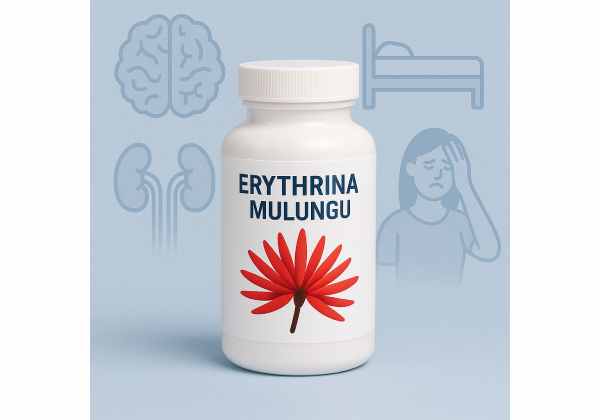
Erythrina mulungu—often called “mulungu”—is a South American tree long used in Brazilian traditional medicine as a soothing, sleep-supportive herb. Modern lab studies point to distinctive erythrinian alkaloids (such as erythravine and 11-α-hydroxyerythravine) that act on brain nicotinic acetylcholine receptors. Small human trials have explored mulungu for short-term anxiety around dental procedures, usually given as a single capsule dose about an hour before surgery. Results are mixed: some studies report a perceived calming effect, while a larger randomized trial did not find clear benefit compared with placebo. As with many botanicals, product quality and standardization vary, and long-term safety data are limited. This guide translates the research into straightforward, practical advice—what mulungu is, how it might work, where it may help, what dose has been studied, and who should avoid it—so you can discuss options with a qualified clinician.
Key Insights on Erythrina mulungu
- May support short-term calming before procedures; evidence remains limited and mixed.
- Lab data suggest erythrinian alkaloids modulate nicotinic receptors linked to arousal.
- Studied dose: 500 mg oral extract taken once, about 60 minutes pre-procedure.
- Causes drowsiness; avoid driving, alcohol, and sedatives around use.
- Avoid in pregnancy, while breastfeeding, with significant liver disease, or before operating machinery.
Table of Contents
- What is Erythrina mulungu?
- Does it actually calm anxiety?
- How to take it: forms and timing
- How much should I take?
- Safety: who should avoid it?
- What the science says so far
What is Erythrina mulungu?
Mulungu (Erythrina mulungu Mart. ex Benth.) is a medium-sized tree native to Brazil and neighboring regions. In folk practice, the bark and, less commonly, flowers and leaves are prepared as a tea or tincture for calming, easing nervous tension, and supporting sleep. Like other species in the Erythrina genus, mulungu contains a family of tetracyclic “erythrinian” alkaloids. Two of the best-studied—(+)-erythravine and (+)-11-α-hydroxyerythravine—appear to influence brain signaling pathways that regulate vigilance and startle responses.
Why this matters: instead of broadly depressing the central nervous system (as alcohol or some sedatives do), these alkaloids target nicotinic acetylcholine receptors, including α4β2 and α7 subtypes. Those receptors are part of the brain’s arousal circuitry. In cell and animal models, selective inhibition at these receptors can reduce anxiety-like behaviors without causing heavy motor impairment. That pharmacology helps explain traditional reports of “calm without grogginess,” though real-world effects depend heavily on dose, extract composition, and individual sensitivity.
Key constituents often discussed in research:
- Alkaloids: (+)-erythravine, (+)-11-α-hydroxyerythravine, (+)-erysothrine, and related compounds (primary candidates for anxiolytic actions).
- Flavonoids and phenolics: minor components with potential antioxidant or modulatory effects, not considered the main drivers of calming activity.
Botanical identity and product variability: “Mulungu” also labels related species (e.g., Erythrina verna, E. velutina) in commerce. While these species share similar alkaloids, their profiles and strengths differ. Responsible manufacturers specify the exact species and the part used (commonly stem bark) and may standardize to total alkaloids. Because mislabeled or non-standardized products can under- or overshoot expected effects, quality control is essential for consistent outcomes and safety.
Regulatory status: mulungu is sold as an herbal product in some countries but not approved as a drug for anxiety. That means doses and quality vary across brands, and clinicians rely on the small human studies and broader pharmacology to guide cautious, short-term use.
Use cases people ask about: occasional situational anxiety (e.g., before dental work), pre-sleep wind-down, and tense restlessness. Evidence is strongest—though still preliminary—for one-time, pre-procedure dosing; data for chronic daily use are sparse. If your goal is ongoing generalized anxiety support, look for options with stronger clinical evidence and discuss with your clinician.
Does it actually calm anxiety?
Here’s the honest read of the literature:
- Mechanistic plausibility: Multiple laboratory studies show mulungu alkaloids inhibit nicotinic receptors involved in arousal. In whole-cell patch-clamp experiments, (+)-erythravine and (+)-11-α-hydroxyerythravine blocked α4β2 receptors at low nanomolar to low micromolar concentrations and also modulated α7 receptors. This aligns with an anxiolytic-like profile in animal models.
- Early human signal (small study): A randomized, double-blind, crossover trial in 30 adults undergoing bilateral wisdom tooth extractions compared 500 mg mulungu with placebo taken 60 minutes before each procedure. Participants more often preferred the mulungu session, especially those with higher baseline anxiety. Physiologic measures (blood pressure, heart rate, oxygen saturation) did not differ substantially, and drowsiness was the main reported effect. The study’s subjective “preference” outcome and small size mean we should treat it as an encouraging signal, not definitive proof.
- Larger modern RCT: A triple-blind, randomized, parallel trial in 200 adults compared 500 mg mulungu, 500 mg Passiflora incarnata, and 15 mg midazolam for pre-extraction anxiety. In that head-to-head context, Passiflora performed similarly to midazolam, while mulungu did not differ from placebo on the primary measures. The take-home: mulungu may help some people in specific, narrow situations, but current evidence does not show reliable, clinically significant anxiolysis across broader groups at the dose tested.
- Systematic evidence view: A 2023 evidence-based review of Erythrina genus plants highlights promising preclinical data and notes that human trials are few and methodologically limited. It calls for standardized extracts, pharmacokinetic data, and dose-finding studies.
How to interpret “mixed” findings: Different extracts can vary in total and relative alkaloid content; timing, expectations, and individual sensitivity all matter in acute anxiety settings. If an extract is alkaloid-poor or poorly absorbed, it may do little at a 500 mg dose; conversely, an alkaloid-rich product could produce noticeable sedation. The larger RCT suggests that, even under careful conditions, mulungu is not consistently anxiolytic at 500 mg for everyone.
What mulungu is not: a proven long-term controller of generalized anxiety disorder, nor a substitute for cognitive-behavioral therapy, SSRIs/SNRIs, or clinician-guided care when those are indicated. Think of mulungu, if used at all, as a potential short-term adjunct for situational tension, tested cautiously and discontinued if ineffective or overly sedating.
How to take it: forms and timing
If you and your clinician decide to trial mulungu for short-term calming, plan your approach before an event that typically makes you tense (for example, a dental procedure or a high-stress appointment). Practical pointers:
Common forms you will see
- Capsules or tablets labeled “Erythrina mulungu (bark) extract.” Some specify “standardized to total alkaloids”; many do not.
- Tinctures (hydroalcoholic extracts). Strength varies—often listed as a ratio of plant to solvent (e.g., 1:5).
- Traditional decoction (tea) made from bark chips. Preparation involves simmering and straining; potency depends on bark quality and time.
Timing
- Studies using capsules gave a single oral dose about 60 minutes before a stressor (e.g., surgery). If you try mulungu, mirror this timing to assess effect while minimizing residual sedation later in the day.
First-trial strategy
- Test on a quiet day first. Take the planned dose when you have no driving, childcare, or safety-critical tasks for the next 6–8 hours. Gauge drowsiness, lightheadedness, or paradoxical stimulation.
- Avoid stacking depressants. Do not combine with alcohol, benzodiazepines, Z-drugs, opioids, or other sedatives.
- Hydration and posture. Sit or lie down if you feel light-headed, and hydrate. Some users report mild hypotensive-like sensations.
- Record the response. Note the time to onset (often 30–90 minutes), perceived calm, and any side effects. Share these details with your clinician.
Product selection tips
- Prefer brands that identify species (Erythrina mulungu), plant part (bark), and either extraction solvent or alkaloid content.
- Be wary of blends or products that fail to specify species/part; different Erythrina species can behave differently.
- For tinctures and teas, avoid escalating volume to “chase” an effect; potency is not standardized, and more is not safer.
When it might fit
- Short-term, situational tension where a single dose could help you feel calmer without heavy motor impairment—as suggested by early trials.
- Not ideal for daily, indefinite use due to limited long-term safety data and the potential for cumulative sedation.
Pair wisely
- Combine with non-drug strategies: controlled breathing, brief mindfulness, realistic preparation for the event, and good sleep hygiene.
How much should I take?
Because mulungu is not an approved anxiolytic drug and products are not standardized, there is no universally accepted daily dose. The clearest human data come from pre-procedure studies:
- Single-dose protocol studied: 500 mg oral extract, taken once, ~60 minutes before a dental extraction. In a small crossover study, more participants preferred the mulungu session; in a larger randomized trial, 500 mg did not outperform placebo. These two results frame realistic expectations: some individuals report benefit; many do not.
If you and your clinician choose to trial mulungu:
- Start low and single-occasion. Begin with the studied single 500 mg dose on a non-driving day to test personal sensitivity.
- Do not “stack” doses the same day. If you feel nothing at 90 minutes, do not take additional capsules, especially if you lack alkaloid standardization data.
- Do not convert this into a daily regimen without medical guidance; evidence for chronic use is minimal, and sedation may accumulate.
- Teas and tinctures: Traditional decoctions lack standard potency. If using a tincture, follow the specific manufacturer’s label and your clinician’s guidance; do not exceed labeled servings, and avoid combining with other sedatives.
Signs you took too much for your body: heavy drowsiness, sluggish reflexes, dizziness upon standing, or a “hung-over” feeling. In that case, discontinue and discuss alternatives with a clinician.
Important caveat on “dose ranges”: You may see online suggestions spanning 100–500 mg per serving or directions for bark teas. These are not consistently tied to standardized alkaloid levels. Use the single 500 mg pre-event dose as your reference point from clinical studies, and avoid chronic, unsupervised use.
Safety: who should avoid it?
Common effects
- Drowsiness is the main effect reported in clinical settings. Plan for no driving or machinery operation after a dose.
- Some people notice lightheadedness or a “relaxed” heaviness. Sit or lie down until it passes. Hydrate.
Less common concerns
- Blood pressure: Traditional sources describe hypotensive tendencies; clinical vitals in trials were stable, but use caution if you already run low or take antihypertensives.
- Liver health: Robust human hepatotoxicity data are lacking; because alkaloids are metabolized by the liver, those with significant liver disease should avoid mulungu unless a specialist approves and monitors.
- Allergy: Avoid if you’ve reacted to Erythrina species.
Interactions to avoid
- Sedatives: benzodiazepines, Z-drugs (zolpidem), barbiturates, opioids, some antihistamines, and alcohol. Combining can over-sedate and impair breathing or reflexes.
- Other CNS-active herbs: kava, valerian, hops—stacking multiplies sedation and complicates monitoring.
- Cognition-critical tasks: pilots, drivers, heavy equipment operators—avoid mulungu on duty days.
Who should not use mulungu
- Pregnant or breastfeeding individuals. There is no adequate safety data.
- Children and adolescents. Not studied; avoid.
- People with significant liver disease or complex polypharmacy (e.g., multiple CNS medications, narrow-therapeutic-index drugs).
- Anyone with upcoming procedures requiring informed consent or memory of instructions—discuss with your clinician; residual sedation can interfere.
Discontinue and seek care if you experience severe dizziness, fainting, shortness of breath, chest pain, confusion, or persistent jaundice or dark urine (rare but concerning).
Bottom line: treat mulungu like a sedating botanical—trial it cautiously, use it seldom, and keep your clinician in the loop, especially if you take prescription medications or have chronic conditions.
What the science says so far
Mechanism: Erythrinian alkaloids from mulungu inhibit neuronal nicotinic acetylcholine receptors (notably α4β2 and α7), which mediate arousal and attention. In lab systems, (+)-erythravine blocks α4β2 currents at low-nanomolar levels and α7 at micromolar levels. This receptor profile plausibly reduces hyperarousal without heavy motor impairment in animals.
Animal data: Multiple rodent studies report anxiolytic-like behavior with mulungu extracts or isolated alkaloids, often comparable to diazepam in standard tests, with less motor disruption. These studies support mechanistic plausibility but don’t establish human dosing.
Human trials:
- Crossover trial (n = 30): 500 mg mulungu 60 minutes before each of two extraction sessions increased participant preference for the mulungu session; vitals remained stable; drowsiness was the main side effect. Subjective preference is a weaker endpoint, and the sample was small.
- Triple-blind RCT (n = 200): 500 mg mulungu vs. 500 mg Passiflora incarnata vs. 15 mg midazolam before third-molar surgery. Passiflora matched midazolam; mulungu did not differ from placebo on primary outcomes. This suggests inconsistent or insufficient anxiolysis for mulungu at 500 mg in this setting.
Synthesis: The receptor pharmacology is compelling, and early human data are intriguing but not consistently positive. If mulungu helps, it likely does so as short-term situational support for some individuals, not as a reliable stand-alone anxiolytic. Better trials need standardized extracts (defined alkaloid content), dose-finding, and broader anxiety indications.
Practical implication: If you try mulungu, use the studied one-time 500 mg dose, avoid sedative combinations, and judge benefit vs. drowsiness. If it’s not clearly helpful, don’t escalate; consider better-supported options and non-pharmacological strategies.
References
- Effect of Erythrina mulungu on anxiety during extraction of third molars 2014 (RCT)
- Herbal medicines as anxiolytics prior to third molar surgical extraction. A randomized controlled clinical trial 2021 (RCT)
- Erythrina mulungu alkaloids are potent inhibitors of neuronal nicotinic receptor currents in mammalian cells 2013 (Mechanistic)
- New insights in the mode of action of (+)-erythravine and (+)-11α-hydroxy-erythravine alkaloids 2020 (Mechanistic)
- Pharmacology activity, toxicity, and clinical trials of Erythrina genus plants (Fabaceae): an evidence-based review 2023 (Systematic Review)
Disclaimer
This information is educational and is not a substitute for professional medical advice, diagnosis, or treatment. Always talk with your healthcare professional before starting, stopping, or combining any supplement—especially if you are pregnant or breastfeeding, have liver or cardiovascular conditions, or take medicines that affect the central nervous system. If you experience concerning symptoms after using a product, seek medical attention promptly.
If you found this guide useful, consider sharing it with a friend on Facebook, X (Twitter), or your preferred platform, and follow us for future evidence-based articles. Your support helps us keep producing high-quality, independent health content.










